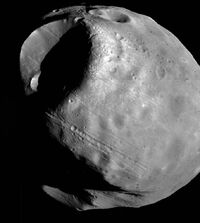
The large crater (mostly in darkness) on the upper left is Stickney.
In the broadest sense, the term impact crater can be applied to any depression, natural or manmade, resulting from the high velocity impact of a projectile with larger body. In most common usage, the term is used for the approximately circular depression in the surface of a planet, moon or other solid body in the Solar System, formed by the hyper-velocity impact of a smaller body with the surface. Impact craters typically have raised rims, and they range from small, simple, bowl-shaped depressions to large, complex, multi-ringed, impact basins. Meteor Crater is perhaps the best-known example of a small impact crater on the Earth, yet on Earth, wind, water and plant life erode impact craters over time.
Large craters could be useful on small planetoids, as a simple geodesic dome could be build within it, enclosing an atmosphere and providing some protection from cosmic rays. Polar craters of Mercury and the Moon likely contain water-ice deposits which would be extremely useful to colonists (as water would not need to be transported there).
On moons of the gas giants or kuiper belt objects, the walls of impact craters would be made of mostly water and frozen gases, meaning a heated dome habitat could sublimate or melt the surounding ices, leading to a collapse of the crater and total destruction of the habitat.